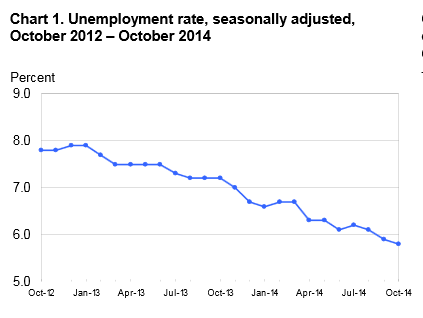Employment Blog November 2014
The following report is from the Bureau of Labor Statistics, US Department of Labor. Non-farm payroll employment increased by 214,000 in October, and the unemployment rate edged down to 5.8 percent. Employment rose in food services and drinking places, retail trade, and health care. Incorporating revisions for August and September, which increased total non-farm payroll employment by 31,000, monthly job increases have averaged 224,000 over the past 3 months. In the 12 months prior to October, employment growth averaged 222,000 per month. This information is summarized in the Charts 1 and 2 below.
In the service-providing sector, food services and drinking places added 42,000 jobs in October, compared with an average monthly gain of 26,000 over the prior 12 months. Employment in retail trade increased by 27,000 in October. Job gains occurred in general merchandise stores (+12,000) and automobile dealers (+4,000). Health care employment grew by 25,000 in October, following a similar-sized increase in September. Over the year, health care has added 257,000 jobs. Within the industry, ambulatory health care contributed 19,000 to the over-the-month job growth.
Employment in professional and business services continued to trend up over the month (+37,000). Over the prior 12 months, job gains in the industry averaged 56,000 per month. In October, employment continued on an upward trend in temporary help services and in computer systems design and related services (+15,000 and +7,000, respectively).
Employment in transportation and warehousing also continued to trend up in October (+13,000).
Turning to the goods-producing sector, manufacturing employment continued trending up in October (+15,000), with over-the-month gains occurring in machinery (+5,000), furniture and related products (+4,000), and semiconductors and electronic components (+2,000).
Construction employment also continued on an upward trend in October (+12,000). Within the industry, employment among residential specialty trade contractors edged up by 10,000. Over the year, construction has gained 231,000 jobs.
Average hourly earnings of all employees on private nonfarm payrolls rose by 3 cents to $24.57 in October. Over the 12 months ending in October, average hourly earnings grew by 2.0 percent. From September 2013 to September 2014, the Consumer Price Index for All Urban Consumers (CPI-U) increased by 1.7 percent.
Turning to measures from the survey of households, the unemployment rate edged down to 5.8 percent in October. Since the beginning of the year, the jobless rate is down by 0.8 percentage point.
The labor force participation rate was 62.8 percent in October and has been essentially flat since April. The employment-population ratio rose in October to 59.2 percent.
In October, the number of people working part time for economic reasons was 7.0 million, about unchanged over the month. (These individuals, also referred to as involuntary part-time workers, would have preferred full-time employment, but had their hours cut or were unable to find full-time work.) Among people who were neither working nor looking for work in October, 2.2 million were classified as marginally attached to the labor force, little changed over the year. (These individuals had not looked for work in the 4 weeks prior to the survey but wanted a job, were available for work, and had looked for a job within the last 12 months.) The number of discouraged workers, a subset of the marginally attached who believed that no jobs were available for them, was 770,000 in October, also little changed over the year.
Regional Variations continued to be significant. Table A details states with unemployment rates significantly above and below the national averages. The lowest rates continue to be North and South Dakota and the upper Mountain and Planes states. Highest rates are in California and a number of the Southern states.



